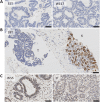Germline mutations and somatic inactivation of TRIM28 in Wilms tumour
- PMID: 29912901
- PMCID: PMC6005459
- DOI: 10.1371/journal.pgen.1007399
Germline mutations and somatic inactivation of TRIM28 in Wilms tumour
Abstract
Wilms tumour is a childhood tumour that arises as a consequence of somatic and rare germline mutations, the characterisation of which has refined our understanding of nephrogenesis and carcinogenesis. Here we report that germline loss of function mutations in TRIM28 predispose children to Wilms tumour. Loss of function of this transcriptional co-repressor, which has a role in nephrogenesis, has not previously been associated with cancer. Inactivation of TRIM28, either germline or somatic, occurred through inactivating mutations, loss of heterozygosity or epigenetic silencing. TRIM28-mutated tumours had a monomorphic epithelial histology that is uncommon for Wilms tumour. Critically, these tumours were negative for TRIM28 immunohistochemical staining whereas the epithelial component in normal tissue and other Wilms tumours stained positively. These data, together with a characteristic gene expression profile, suggest that inactivation of TRIM28 provides the molecular basis for defining a previously described subtype of Wilms tumour, that has early age of onset and excellent prognosis.
Conflict of interest statement
The authors have declared that no competing interests exist.
Figures





References
-
- Breslow N, Olshan A, Beckwith JB, Green DM. Epidemiology of Wilms tumor. Med Pediatr Oncol. 1993;21: 172–81. - PubMed
-
- Haber DA, Buckler AJ, Glaser T, Call KM, Pelletier J, Sohn RL, et al. An internal deletion within an 11p13 zinc finger gene contributes to the development of Wilms' tumor. Cell. 1990;61: 1257–69. - PubMed
-
- Kreidberg JA, Sariola H, Loring JM, Maeda M, Pelletier J, Housman D, et al. WT-1 is required for early kidney development. Cell. 1993;74: 679–91. - PubMed
-
- Wilm B, Munoz-Chapuli R. The Role of WT1 in Embryonic Development and Normal Organ Homeostasis. Methods Mol Biol. 2016;1467: 23–39. doi: 10.1007/978-1-4939-4023-3_3 - DOI - PubMed
-
- Koesters R, Ridder R, Kopp-Schneider A, Betts D, Adams V, Niggli F, et al. Mutational activation of the beta-catenin proto-oncogene is a common event in the development of Wilms' tumors. Cancer Res. 1999;59: 3880–2. - PubMed
Publication types
MeSH terms
Substances
LinkOut - more resources
Full Text Sources
Other Literature Sources
Medical
Miscellaneous

